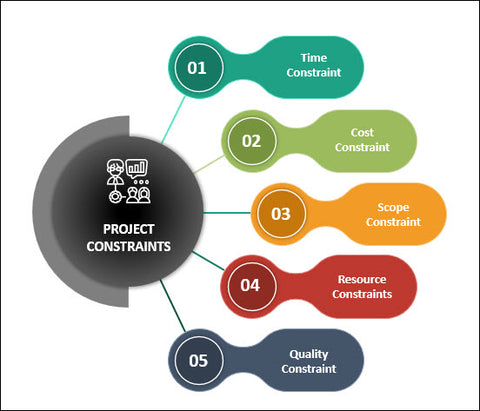Project Constraints: What Are They And Manage Them For Project Success?
Project constraints are inherent limitations or boundaries that impact the planning, execution, and outcome of a project. They define the boundaries within which a project must operate and can include factors such as time, budget, resources, scope, and external influences. Effectively managing project constraints is crucial for project success, as it enables project teams to navigate challenges, make informed decisions, and deliver outcomes within the defined limitations.

In this topic, we will explore the concept of project constraints in detail. We will discuss the different types of constraints that can arise in a project, the impact they have on project management, and strategies for managing and mitigating these constraints to achieve project success. By understanding the nature of project constraints and implementing appropriate management techniques, project managers can optimize project outcomes and deliver successful results within the given constraints.
Defining Project Constraints
Project constraints are the limitations and boundaries that shape the planning, execution, and completion of a project. They define the parameters within which a project must operate and have a significant impact on project management decisions and outcomes. The three primary constraints commonly referred to as the "triple constraint" are:
Time Constraint: This refers to the fixed timeline or deadline within which the project must be completed. It encompasses the project's duration, milestones, and delivery deadlines. Time constraints often arise from external factors, such as contractual agreements, market demands, or regulatory requirements.
Cost Constraint: The cost constraint relates to the available budget or financial resources allocated to the project. It includes factors such as project funding, resource costs, and expenses. Managing the project within the given budget and avoiding cost overruns is crucial for ensuring financial viability and meeting stakeholder expectations.
Scope Constraint: The scope constraint defines the boundaries and deliverables of the project. It encompasses the specific features, requirements, and objectives that the project aims to achieve. Scope constraints involve determining what is within the project's scope and what is not. Managing scope effectively ensures that the project stays focused and delivers the desired outcomes.
Resource Constraints: These constraints relate to the availability and allocation of project resources, such as human resources, equipment, technology, and materials. Limited or constrained resources can impact project scheduling, quality, and overall success.
Quality Constraints: Quality constraints pertain to the level of excellence or standards that the project deliverables must meet. These constraints are defined by customer expectations, industry standards, or specific quality requirements. Balancing quality requirements with other constraints is crucial for meeting project objectives.
Types Of Project Constraints
Project constraints can vary depending on the specific project and its context. Here are some common types of project constraints:
Time Constraint: This constraint refers to the fixed duration or timeline within which the project must be completed. It includes project milestones, deadlines, and critical time-sensitive activities. Time constraints are often influenced by external factors such as project launch dates, contractual agreements, or regulatory requirements.
Cost Constraint: Cost constraints pertain to the financial resources allocated to the project. They include the project budget, funding limitations, and cost considerations for resources, materials, and services. Managing the project within the defined budget and avoiding cost overruns is essential for financial control and successful project delivery.
Scope Constraint: The scope constraint defines the boundaries and deliverables of the project. It includes the specific objectives, features, and requirements that the project aims to accomplish. Managing scope involves determining what is included and excluded from the project scope, maintaining scope clarity, and avoiding scope creeps.
Resource Constraint: Resource constraints refer to limitations or availability of project resources such as human resources, equipment, technology, or materials. Projects may face constraints due to limited resource availability, skills shortage, or competing resource demands. Effective resource management is crucial to optimize resource utilization and ensure project efficiency.
Understanding The Impact Of Constraints On Project Success
Achieving Project Objectives: Constraints define the boundaries within which the project must operate. They shape the project's goals, scope, timeline, and budget. Adhering to these constraints is crucial for aligning project activities with the desired outcomes. Failing to manage constraints effectively can result in project objectives being compromised or not fully realized.
Resource Utilization: Constraints such as limited resources or budget restrictions can impact resource allocation and utilization. Project teams must carefully manage available resources to ensure optimal usage and productivity. Failure to do so can lead to resource shortages, bottlenecks, or compromised project deliverables.
Schedule Management: Schedule Management Time constraints play a critical role in project scheduling and completion. Meeting project deadlines is essential for overall project success. Failure to manage time constraints can result in project delays, missed milestones, and negative impacts on subsequent project activities or dependencies.
Budget Control: Cost constraints influence project financials and budget management. Staying within the defined budget is crucial to ensure project viability and stakeholder satisfaction. Poor cost control can lead to budget overruns, financial strain, and potential project termination.
Identify And Prioritize Constraints.
- Gather Stakeholder Inputs: Engage with project stakeholders, including clients, sponsors, team members, and other relevant parties. Collect their inputs on the constraints they perceive or anticipate. Stakeholders often have valuable insights regarding constraints that may impact the project's success.
- Conduct A Constraints Analysis: Review project documentation, requirements, and any relevant agreements or contracts. Identify potential constraints based on factors such as project objectives, scope, timeline, budget, resources, quality standards, and stakeholder expectations. Consider both internal and external constraints that may arise.
- Evaluate Constraint Significance: Assess the significance and impact of each identified constraint on the project. Consider factors such as the degree of influence the constraint has on project success, the potential consequences of not addressing it, and its alignment with project objectives. Prioritize constraints based on their potential impact.
- Assess Dependency And Interactions: Examine the interdependencies between different constraints. Some constraints may have a direct influence on others or may interact in complex ways. Understand how changes or adjustments to one constraint may impact others and evaluate them accordingly.
- Seek Expert Advice: Consult subject matter experts or experienced professionals who have expertise in the project domain or similar projects. They can provide insights into potential constraints that may not be immediately apparent and offer guidance on prioritization based on their experiences. Managing constraints effectively.
- Define Clear Project Objectives: Start by establishing clear and specific project objectives. Having well-defined goals helps in understanding the boundaries within which the project needs to operate and allows for better constraint management.
- Conduct Comprehensive Planning: Develop a detailed project plan that considers all identified constraints. This includes creating a project schedule, allocating resources effectively, and defining project scope and deliverables. A thorough plan helps in identifying potential conflicts or limitations early on and allows for appropriate mitigation strategies.
- Prioritize And Communicate: Prioritize constraints based on their impact on project success and stakeholder satisfaction. Clearly communicate the constraints to the project team and stakeholders, ensuring everyone understands the limitations and their implications. Regularly update and communicate any changes or adjustments to the constraints as the project progresses.
- Employ Effective Change Management: Anticipate and plan for potential changes to constraints throughout the project. Establish a change management process that allows for evaluating and managing changes to constraints in a controlled manner. This helps in addressing evolving needs or external factors without compromising project objectives.
- Risk Management: Integrate risk management into constraint management. Identify potential risks associated with each constraint and develop appropriate risk mitigation strategies. Regularly monitor and assess risks, adapting mitigation measures as needed to minimize their impact on the project.
Best Practices For Managing Project Constraints.
Clearly Define And Document Constraints: Begin by clearly defining and documenting all project constraints, including scope, budget, schedule, resources, quality standards, and any other relevant limitations. Make sure the constraints are well understood and agreed upon by all stakeholders to avoid misunderstandings later on.
Prioritize Constraints: Prioritize constraints based on their impact on project success and stakeholder satisfaction. Understand which constraints critical and non-negotiable, and which ones are allow for flexibility. This prioritization helps in making informed decisions and trade-offs when managing constraints.
Involve Stakeholders: Engage stakeholders in the constraint management process from the beginning. Regularly communicate with stakeholders to understand their expectations, concerns, and perspectives related to the constraints. Involve them in decision-making processes and keep them informed about any changes or updates to the constraints.
Continuously Monitor And Assess: Monitor and assess the progress and performance of the project in relation to the defined constraints. Regularly track key performance indicators (KPIs) and measure progress against planned activities and milestones. This allows for early detection of potential issues and prompt corrective actions.
Proactive Risk Management: Identify and manage risks associated with constraints proactively. Conduct a comprehensive risk assessment, develop risk mitigation strategies, and monitor risks throughout the project lifecycle. Regularly reassess risks as constraints evolve or project circumstances change.
Conclusion :
In conclusion, project constraints are the limitations and boundaries that define the scope and parameters of a project. They include factors such as budget, schedule, resources, scope, quality standards, and stakeholder expectations. Effectively managing project constraints is essential for project success. By understanding, prioritizing, and managing constraints, project teams can navigate challenges, make informed decisions, and deliver successful outcomes.




